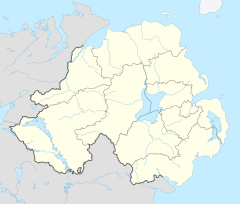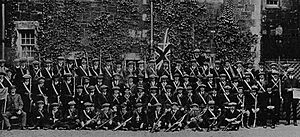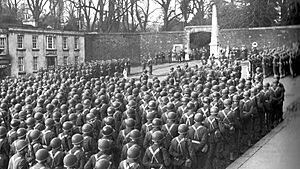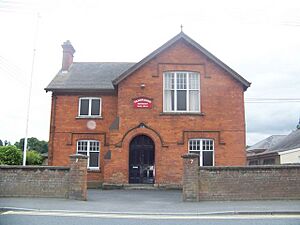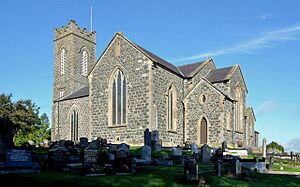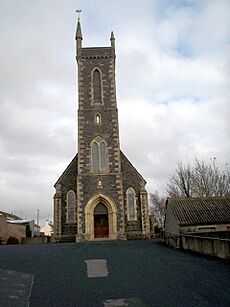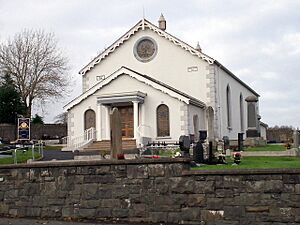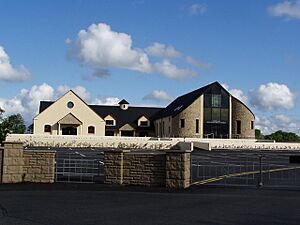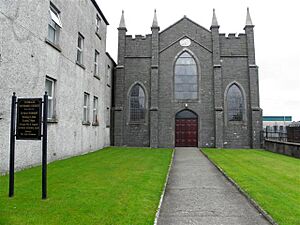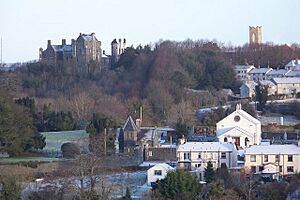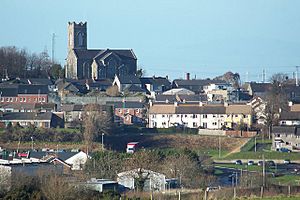Tandragee facts for kids
Quick facts for kids Tandragee
|
|
|---|---|
| Town | |
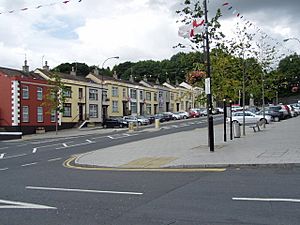 The Square, Tandragee (2009) |
|
| Population | 3,545 (2021 census) |
| Irish grid reference | J030462 |
| • Belfast | 25 mi (40 km) |
| District |
|
| County | |
| Country | Northern Ireland |
| Sovereign state | United Kingdom |
| Post town | CRAIGAVON |
| Postcode district | BT62 |
| Dialling code | 028 |
| Police | Northern Ireland |
| Fire | Northern Ireland |
| Ambulance | Northern Ireland |
| EU Parliament | Northern Ireland |
| UK Parliament |
|
| NI Assembly |
|
Tandragee is a town in County Armagh, Northern Ireland. Its name comes from the Irish Tóin re Gaoith, meaning "backside to the wind". The town sits on a hillside above the Cusher River. It is watched over by the historic Tandragee Castle. In 2021, about 3,545 people lived there.
| Top - 0-9 A B C D E F G H I J K L M N O P Q R S T U V W X Y Z |
Tandragee's Past
Overlooking Tandragee is Tandragee Castle. It was once the home of the O'Hanlon clan's chief. He was the Lord of Orior. Some O'Hanlons joined the Nine Years' War. Because of this, the castle and land were taken from them. They were given to Oliver St John.
Tandragee Castle was rebuilt around 1837. It had been destroyed during the Irish Rebellion of 1641. The castle was rebuilt for George Montagu, 6th Duke of Manchester. Since 1956, the castle grounds have been home to the Tayto potato-crisp factory. Businessman Thomas Hutchinson bought the land for the factory.
Irish Rebellion of 1641
On October 23, 1641, Irish rebels attacked Tandragee. They were led by Patrick and Edmond O'Hanlon. They wanted to take back their family's land. The rebels burned the Ballymore church. They also burned Captain Oliver St John's castle. This destroyed much of the town. Reports say they also killed Protestant settlers.
In April 1642, Felim O'Neill led the rebellion. He told his forces to meet at Tandragee. They would prepare to fight the Scots Covenanters. About 2,000 soldiers came to O'Neill's call.
On May 12, 1643, General Robert Monro led 4,000 Covenanters to Tandragee. They burned homes in the area. Felim O'Neill's soldiers fought Monro's men. During this fight, several of Monro's soldiers died. The O'Hanlons lost control of Tandragee. The castle was left in ruins after the conflict.
On September 9, 1679, followers of Redmond O'Hanlon killed Henry St John. He was the owner of Tandragee Castle at the time. This happened while he was riding near Knockbridge.
Tandragee Volunteers
In the late 1700s, Britain was fighting the American Revolutionary War. This made people worry about attacks from France and Spain. So, groups called Irish Volunteers formed in Ireland. They were armed and run by themselves. Most were Protestants. Several groups started in the Tandragee area.
Captain Nicholas Johnston started the Tandragee Volunteers in 1779. They wore red uniforms with white details. Johnston also set up another group called the Tandragee Invincibles. A grave in the churchyard honors John Whitten, a volunteer who died in 1785.
Other groups included the Tandragee Light Dragoons. They were led by James Craig. The Volunteers mostly did parades and shooting contests. The Tandragee Volunteers were part of a fight at Lisnagade in 1791. A group of Catholic Defenders camped there. They planned to fight Protestant Peep O' Day Boys. This fight inspired a song called Lisnagade.
The Volunteers' power lessened after the American Revolutionary War. New government-backed groups like the Yeomanry appeared. After the Battle of the Diamond, the Yeomanry joined with the Orange Order. The Tandragee Yeomanry formed in 1796. They helped stop the 1798 United Irishmen Rebellion. A newspaper said 40,000 people met at a protest in Tandragee. With the Volunteers gone and the United Irishmen defeated, the Acts of Union 1800 ended the Irish Parliament.
Home Rule Crisis
When the First Home Rule Bill was introduced in 1886, Protestants in Tandragee strongly disagreed. They helped create a plan for an 'Orange Army'. An effigy of Prime Minister William Gladstone was burned in the town. This happened after a protest against Home Rule.
Tandragee also had many members in the Ulster Defence Union. In 1886, eight local people represented the area. They were Rev. P.A. Kelly, Rev. W. McEndoo, Rev. R.J. Whan, Maynard Sinton, Thomas White, William O’Brien, John Atkinson, and Rev. George Laverty.
In 1910, Unionist Club branches started in Tandragee and nearby towns. In September, members of the Tandragee Club practiced drills. This was before the Ulster Covenant. William Montagu, 9th Duke of Manchester watched them.
During the Third Home Rule Crisis, the Ulster Unionist Party leaders decided to unite different unionist paramilitary groups. By December 1912, the County Armagh Committee included local business people, lawyers, and nobles. Rev. R.J. Whan and George Davison represented Tandragee. These people helped form a local group of the Ulster Volunteers.
In 1912, the Royal Irish Constabulary noted Tandragee as a place where unionist groups were drilling. Most people in the Tandragee area joined the Third Battalion of the County Armagh Regiment of the Ulster Volunteer Force. This group was also called the Tandragee Volunteers. Tandragee Castle was their main base. The 9th Duke of Manchester sometimes checked on the troops. He also let them use his estate.
A mural honoring the Third Battalion of the County Armagh Regiment UVF is in Tandragee. It is at the corner of Montague Street and Ballymore Road.
World War I
On August 4, 1914, the UK entered World War I. Thousands of Ulster Volunteers joined the British Army. A public effort helped the Ulster Volunteer Force join Kitchener's new Army. Hundreds from Tandragee joined. Many joined the 9th Battalion Royal Irish Fusiliers. About 60 to 70 volunteers marched through Tandragee. They were led by a flute band. Then they left from Madden Bridge Railway Station.
Peace Day was celebrated in Tandragee on July 19, 1919. There was a costume parade and sports day. These events took place on the Duke of Manchester's land. In the evening, a parade with an effigy of the Kaiser went to the square. The effigy was then burned.
The Tandragee war memorial was unveiled in April 1925. It was the first in County Armagh. A large crowd gathered for the ceremony. After a hymn, Major Shellington MP unveiled the memorial. The tall stone monument is nearly 25 feet high. It is made of Newry granite. It stands in the square near the castle gates.
World War II
On May 25, 1942, a Spitfire BL325 crashed near Tandragee. The plane was part of a training exercise. The pilot hit a tree during a low flight. The plane landed upside down in a field.
A year later, life in Tandragee changed. American GIs from the 6th Cavalry arrived. In 1943, Alexander Montagu, the 10th Duke of Manchester, leased Tandragee Castle to the United States Army. They used it during World War II.
Tandragee was a good location for the US Army in 1943. It was near the main Belfast-Dublin railway. It was also close to the River Cusher and Newry Canal. Tandragee railway station saw thousands of soldiers arrive during the war.
The 6th Cavalry unit had its last parade in Tandragee on December 31, 1943. After this, the group became the 6th Mechanized Cavalry Group. Reports suggest that General George S. Patton visited Tandragee Castle in 1943. He was a guest at a dance there while inspecting troops.
The Tandragee war memorial honors soldiers from both World War I and World War II.
The Troubles
In February 1973, there was a clash at the Tandragee power station. Three gunmen and British soldiers were involved. One of the gunmen was hit.
In 2000, Tandragee was the site of a tragic event. Two local teenagers, Andrew Robb and David McIlwaine, were killed. This was part of a conflict between loyalist groups.
Orange Order District
Tandragee District No.4 is one of 11 Orange Districts in County Armagh. It has 21 private lodges and nearly 650 members. Every year on The Twelfth (July 12), the lodges hold a "Ring Ceremony" in the square. This includes a short religious service. Tandragee is the only district that does this.
Tandragee District No.4 hosts The Twelfth every 11 years. This is part of a rotation. Each district lodge in County Armagh takes a turn to organize the event.
The district started in 1796, soon after the Orange Order was formed. The first Orange parades in Tandragee were on July 12, 1796. This was the same day as the first Twelfth event at Lurgan Park. At that time, the district had 14 lodges. By 1834, it had 27 lodges with 810 members. In 1900, this number dropped to 25 lodges with 750 members. Today, there are 21 lodges with over 700 members.
On July 12, 1831, 10,000 Orangemen from Ulster gathered in Tandragee. They celebrated the Twelfth. They marched around Lord Mandeville's Castle (Tandragee Castle). The castle gates were decorated with Orange arches. There were also 80 to 90 Orange banners.
Tandragee District Hall was built in 1912. It was first a Protestant Temperance Hall. In the 1940s, the building was a picture house. Later, it was used for dances. Now, it is the Tandragee District Hall. The hall also hosts other events all year.
On New Year's Day 2008, the hall was set on fire. The door was forced open. The inside was burned, and the hall had a lot of smoke damage.
Music in Tandragee
The Hills of Tandragee
A song about the town, The Hills of Tandragee, dates back to 1970. It is similar to another song, The Hills of Glensuili. The main differences are the place names and a few words that change the meaning. In the song, the singer hopes the Orange flag will soon fly over Tandragee's hills. He thinks about the birds and views of Tandragee. He hopes for peace and to return soon.
Folk musician Robin Morton, from nearby Portadown, spoke about the song. He said it is a popular Orange song. People can join in on the last line of each verse. Dick Bamber is often said to have written it. But he says an old lady who lived near him wrote it years ago. He was the first to sing it in public. Now it is a standard Orange song.
Lambeg Drumming
Lambeg drumming is important to the County Armagh Orange Districts. There is a special drumming rhythm named after Tandragee. It is called Tandragee Time. This rhythm is often played throughout County Armagh.
Churches in Tandragee
There are six churches in Tandragee: Ballymore Parish Church, St James's Catholic Church, Tandragee Presbyterian, Tandagee Free Presbyterian, Tandragee Baptist and Tandragee Methodist.
Ballymore Parish Church
Ballymore Parish Church dates back to 1343. It is next to Tandragee Castle on Church Street.
The church has a history of over 650 years. It was linked to the Dukes of Manchester until the 1950s. The church was mentioned in records from the 1300s. But it was burned down by Edmond O'Hanlon in the Irish Rebellion of 1641. It was rebuilt in 1812 because it was too small. During building, old wall parts were found. They showed signs of fire damage from the 1641 rebellion.
St James's Catholic Church
The Roman Catholic Church of Saint James the Apostle was built in 1852. It stands on Market Street. It is part of the Tandragee Catholic parish. This parish is in the Archdiocese of Armagh.
Tandragee Presbyterian Church
Tandragee Presbyterian Church was started by Rev. Dr. Henry Cooke in March 1829. The church building is on Markethill Road. It was built in 1828 and updated in 1977. The church hall is used by the 1st Tandragee Boys' Brigade and Girls' Brigade.
Tandragee Free Presbyterian Church
Tandragee Free Presbyterian Church was formed in 1967. It is located off the Portadown Road. This is in the Willowfield housing estate.
In February 1967, Rev. Ian Paisley led a gospel campaign. It was held at the Protestant Temperance Hall. The hall was full every night. For the last two Sunday meetings, another hall was used. People watched the services on TV there. Many people liked this style of preaching. So, some asked Rev. Paisley to start a new church. They wanted a Free Presbyterian Church in Tandragee. On Easter Sunday, March 26, 1967, Paisley gave a sermon. This led to the start of Tandragee Free Presbyterian Church.
On October 18, 2008, a new church complex opened. It is 16,000 square feet. It serves the growing number of members. It is off the Portadown Road. This new building has a main church area for 450 people. It also has a church hall for 350 people. There is a prayer room for 130 and a youth area for 70. The complex also has offices, storage, and kitchens.
Tandragee Baptist Church
Tandragee Baptist Church was formed on February 29, 1864. It is on the Madden Road.
About two years after the church started, members decided to build a meeting house. They needed to find a good spot first. In October 1866, they agreed to accept land from William Montagu, 7th Duke of Manchester. They would ask for money to build the chapel. The Duke of Manchester leased them land for 91 years. The rent was 30 shillings (£1.50) a year. The chapel was planned to be 60 by 30 feet. It would be built with stone from a nearby quarry. At first, they only had enough money for the walls. But work started again after a donation. The roof was finished. By the end of 1867, the church was open.
The last service at the old church was on April 22, 2001. The building was torn down in May 2001. It was not safe. The roof beams were rotten. A new church building opened in 2002.
Tandragee Methodist Church
Tandragee Methodist Church was built in 1835. It is on Market Street.
Education
Schools in the area include:
- Tandragee Primary School
- Tandragee Junior High School
- Tandragee Nursery
- Button Moon Play Group
Sports in Tandragee
Motorcycling
The Tandragee 100 is a motorcycle race. It has been held in the area since 1958. This 100-mile race has featured famous riders. These include Guy Martin, Joey Dunlop, Ryan Farquhar, and Michael Dunlop. The race was cancelled in 2020 and 2021 due to COVID-19. It was also cancelled in 2023 due to insurance costs. In 2024, it was cancelled again because the course needed resurfacing.
Other Sports
Tandragee Rovers play in the Mid-Ulster Football League. There is a golf course at Tandragee Castle. It is a hilly course, 5,589 meters long. The Tayto Tandragee Soapbox Derby started in 2015. It raises money for the Royal British Legion in Tandragee. In 2019, over 7,500 people visited the event.
Industry and Transport
Thomas Sinton opened a mill in Tandragee in the 1880s. This was an expansion of his business from nearby Laurelvale. Sintons' Mill, by the Cusher River, made products until the 1990s. The mill caught fire in October 2024. Six fire engines from the NI Fire and Rescue Service attended.
White's Mill was started by Thomas Henry White in 1841. It was a mill for corn and flour by the Cusher River. Now, it is Northern Ireland's largest oat miller. It also makes breakfast cereals. In 2023, plans were approved for White's Oats to move to new buildings in Craigavon.
The potato-crisp company Tayto has a factory and offices near Tandragee Castle. They offer guided tours. In November 2019, Prime Minister Boris Johnson visited the Tayto factory.
Taranto Ltd. makes concrete products. Their 70-acre production site is on Scarva Road.
Tandragee Wastewater Treatment Works is owned by NI Water. It is on the Scarva Road.
Northern Ireland Electricity has a power line connecting to County Louth in the Republic of Ireland. It starts from the Portadown Road.
Tanderagee railway station opened on January 6, 1852. It closed on January 4, 1965.
Population Details
2021 Census
Tandragee had 3,545 people in the 2021 census.
- 76.92% were from a Protestant background.
- 10.75% were from a Roman Catholic background.
2011 Census
Tandragee had 3,486 people in 2011. There were 1,382 households.
- 23.26% were under 16 years old.
- 12.62% were aged 65 and above.
- 50.06% of the people were male.
- 49.94% were female.
- 81.84% were from a Protestant background.
- 11.70% were from a Roman Catholic background.
2001 Census
In 2001, Tandragee was a medium-sized town. It had between 2,050 and 4,500 people. On April 29, 2001, 3,050 people lived in Tandragee.
- 24.9% were under 16 years old.
- 14.3% were aged 60 and over.
- 48.0% of the people were male.
- 50.0% were female.
- 86.9% were from a Protestant background.
- 10.5% were from a Roman Catholic background.
- 2.0% of people aged 16–74 were unemployed.
|
See also
 In Spanish: Tandragee para niños
In Spanish: Tandragee para niños


